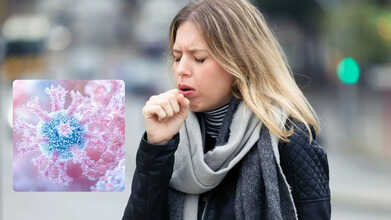- Health Conditions A-Z
- Health & Wellness
- Nutrition
- Fitness
- Health News
- Ayurveda
- Videos
- Medicine A-Z
- Parenting
Pregnancy In Winter: Keep These 5 Rules In Mind For A Healthy Body

Pregnancy In Winter: Keep These 5 Rules In Mind For A Healthy Body
Pregnancy is a fascinating experience, but with each month of pregnancy, comes its own version of challenge especially during the winter months. It becomes cold, the days get shorter, and you have to be ready for your seasonal sickness to sicken you down. Although winter is the most challenging season to enjoy good health and comfort with the birth of a child, it can still be a great time to nourish your body and that of your baby.
Here's how expectant mothers can keep themselves healthy and active during winter pregnancy:
1. Adopt a Healthy, Winter Appropriate Diet
Your body needs some extra supplements to prepare for winter when your immune system works overtime to ward off diseases to your baby and you. A well-balanced diet is the chief factor that encourages good health throughout your period of pregnancy.
- Focus on immune-boosting foods : Emphasize vitamin C rich foodstuffs, such as citrus fruits, bell peppers, and leafy greens. These help ward off colds and keep your immune system up and going.
- Cozy, filling meals : Soups, stews, and root vegetables, like sweet potatoes and carrots, are comforting, filling, and also full of nutrients and minerals that help a healthy pregnancy.
- Keep hydrated: Winter dryness can dehydrate you overnight, so drink up. Herbal teas, warm broths, and fruit-infused water can be lovely alternatives to plain old H2O, too.
2. Exercising and Movement
The benefits of exercise to an expecting mother, of course, are that she can reduce some of the most common pregnancy discomforts, like back pain, swelling, and fatigue. Yes, of course, winter is a very tempting season for staying indoors; however, there are loads of ways you can keep active during the colder months.
Instead, consider indoor exercise. Prenatal yoga, indoor pool swimming, and online fitness classes designed specifically for pregnant women can be a good options for you. These are low-impact exercises; however, they can keep you holding strength and flexibility.
- Walking: If you have an expecting mum near you, walking is one of the safest and most effective ways of staying active during pregnancy. If possible, walk in parks or walk around your neighborhoods; however, be cautious of icy paths. You can also walk in a shopping mall if the weather is too bad.
- Stretching : Keeping yourself limber reduces tension throughout the body, especially throughout pregnancy as your body has a natural tendency to shift and change. Stretching also improves blood flow, which can help alleviate a number of the discomforts that come with pregnancy, such as sciatica.
3. Vaccinations and Check-ups to Safeguard Yourself Against Winter Illnesses
Others include flu and common colds. It's therefore important to be extra careful in being healthy at this point of winter time.
- Get the flu shot: A flu shot taken during pregnancy is also safe and can prevent flu-related complications both in you and your baby.
- Keep personal hygiene high: Always wash your hands; keep a distance from people who fall sick, as contact with them will easily distribute germs everywhere. Purify surfaces that are touched most often.
- Wear layers to stay warm: Avoid catching cold and discomfort from changing temperatures so drastically. Use light warmers and make sure your extremities, such as your hands and feet, are also warm.
4. Rest and Mental Wellness
It's very grueling physically and emotionally to be pregnant, and short days in winter make one even more exhausted. Paying by listening to your body's need for adequate rest is crucial to a good pregnancy.
- Good quality sleep: Ensure that you sleep soundly every night to rejuvenate and nurse your baby. However, if the discomfort causes you to be able to sleep less, you can utilize some pregnancy pillows to discover a comfortable sleeping position.
- Relaxation techniques: The cold and dark days of winter might sometimes get to you. Practice mindfulness, meditate, or get a prenatal massage to ease off some that stress and stay in touch with your body.
- Stay connected : When winter comes, it can easily make you feel isolated; therefore, work hard to connect with friends and family-even virtually. Social support is vital for your emotional health during pregnancy.
5. Track Your Skin and Hydration
Skin tends to change a lot with pregnancy, and it's quite hard to stay hydrating during the colder winter seasons. Dry skin, chapped lips, and itchy skin are some common issues due to the cold air, indoor heating, and the dry environment.
- Moisturize : Use hydrating body lotions or oils that make your skin look nice: soft and smooth. Shea butter, coconut oil, and aloe vera are some safe, natural, and moisturizing options that help in retaining the moisture.
- Lip Protection: Keep your lips moisturized enough to prevent chapping or cracking.
Weight Loss Jabs: What Happens To Your Body When You Stop Taking Them?

Credits: Canva
Weight-loss jabs, or GLP-1 receptor agonists, have provided many people with results that diets alone could not achieve. For those struggling with constant cravings, these medications have quieted the persistent “food noise” that often drives overeating. They have transformed not only body shapes but also self-confidence and daily habits.
Yet questions remain: can people safely stop taking these drugs, and what happens to the body when they do? These are still largely unknown, as the drugs are relatively new. GLP-1s mimic a natural hormone that controls hunger, but the long-term effects are only beginning to be understood. Additionally, for the estimated 1.5 million people in the UK paying privately for these injections, maintaining treatment can be costly.
Two women, Tanya and Ellen, share their personal experiences with the BBC on weight-loss jabs and what life was like when they attempted to stop.
Weight Loss Jabs: Tanya Hall’s Experience
Tanya, a sales manager in the fitness industry, initially started taking Wegovy to challenge her own perceptions about weight and authority. She often felt overlooked or undervalued because of her size, and hoped that losing weight would change how others treated her, as per BBC.
Early in treatment, Tanya experienced side effects including nausea, headaches, sleep issues, and hair loss, which she describes as clumps coming out. Despite this, she steadily lost weight—six stone (38 kg) over 18 months—and the injections quieted the relentless urge to eat.
However, every time she tried to stop, her appetite surged within days, leaving her horrified at her own eating. Now, Tanya continues the medication, feeling it has become essential to maintaining her weight and the confidence it brings.
Weight Loss Jabs: What Happens To Your Body When You Stop Taking Them?
Wegovy’s manufacturer, Novo Nordisk, stresses that treatment decisions should be made with medical guidance and that side effects must be considered. Lifestyle GP Dr. Hussain Al-Zubaidi likens stopping GLP-1s abruptly to being hit by a “tsunami” of hunger.
Research shows that within one to three years of stopping these medications, people can regain 60–80% of the weight they lost. This highlights how these drugs work not just by reducing appetite temporarily but by fundamentally altering hunger cues.
Weight Loss Jabs: Ellen Ogley’s Journey
Ellen turned to Mounjaro after reaching a critical point in her life. Her weight had put her at risk during surgery, and emotional binge eating dominated her daily habits. Once on the medication, Ellen noticed her compulsive eating completely stopped.
Over 16 weeks, she lost 3 st 7 lb (22 kg) and began tapering off the injections over six weeks. She focused on developing a healthier relationship with food, creating balanced meals, and incorporating exercise into her routine. Despite some weight creep after stopping, she has since lost a total of 51 kg and now feels confident her habits are sustainable.
Weight Loss Jabs: The Importance of Support
Dr. Al-Zubaidi emphasizes that exiting GLP-1 treatment safely requires guidance and long-term support. NICE recommends at least a year of tailored advice after stopping injections to help individuals maintain their weight and prevent relapse, as per BBC.
For patients paying privately, such structured support may not always be available, increasing the risk of regaining weight. Lifestyle, mindset, and environmental factors play a significant role in long-term outcomes.
Tanya has chosen to continue with her medication, aware of the pros and cons, while Ellen has closed that chapter and built a sustainable routine for life after Mounjaro.
Weight-loss jabs can dramatically change appetite and body weight, but stopping them can be challenging. The transition off these drugs requires careful planning, support, and lifestyle adjustments. As Tanya and Ellen’s experiences show, the journey varies by individual, and long-term strategies are essential to maintaining health and weight loss results.
Eli Lilly, the manufacturer of Mounjaro, states that patient safety is its top priority and that it continually monitors and reports information on treatment outcomes to regulators and prescribers.
Flu Cases Surge Across The US: How Long Does The Super Flu Remain Contagious?

Credits: Canva
Flu Symptoms: Seasonal infections are spreading across the United States just as the holiday travel rush gets underway, worrying health officials about fresh spikes during family get-togethers. Flu and norovirus cases are rising in several states, while COVID-19 continues to circulate at lower but consistent levels. Together, these illnesses are adding strain on hospitals as millions of people plan to travel in the days ahead.
Flu: What Is Super Flu?
“Super flu” is not a clinical term, but it is often used to describe a flu season that feels more aggressive or spreads faster than usual. This is typically linked to a dominant strain of influenza A. The current surge is being driven by a mutated influenza A strain known as H3N2 subclade K. Health officials say this strain has become the leading flu variant in the US, accounting for roughly 89 percent of H3N2 samples analysed since late September, according to genetic sequencing data from the Centers for Disease Control and Prevention (CDC).
This variant emerged after the 2025–26 flu vaccine was formulated, meaning the vaccine may not be as closely matched as in earlier seasons. While the shot still offers protection against severe disease, experts note that the mismatch could allow the virus to spread more easily.
Flu Symptoms 2025: What Symptoms Should People Watch For?
The symptoms seen in the current flu wave are largely familiar. People may develop fever, chills, extreme tiredness, cough, and body aches. Doctors, however, caution that the wider spread could result in more serious cases, particularly among people who are at higher risk.
CDC estimates indicate that the US has already seen about 4.6 million flu cases this season, along with nearly 49,000 hospital admissions and around 1,900 deaths. Flu activity increased sharply in mid-December, with test positivity jumping from 8.1 percent to 14.3 percent within a single week.
Flu Symptoms 2025: How To Reduce The Risk
Doctors recommend staying home when feeling unwell, washing hands often, especially to limit norovirus spread, and considering vaccination against flu and COVID-19. Even when the strain match is not ideal, experts stress that vaccines remain crucial in reducing the risk of severe illness, hospitalisation, and death.
Flu Cases In The US: How Contagious Is Superflu?
In terms of how easily it spreads, it behaves much like regular flu, which is known to be highly contagious.
Someone with flu can pass on the virus from around one day before symptoms appear and continue to be contagious for five to seven days after becoming sick. Children, older adults, and those with weakened immune systems may remain infectious for a longer period.
The virus mainly spreads through respiratory droplets released when an infected person coughs, sneezes, speaks, or breathes near others. It can also spread through contact with contaminated surfaces, followed by touching the mouth, nose, or eyes. Crowded indoor settings, poor airflow, and close contact make transmission far more likely, which explains why flu spreads quickly during peak season.
What makes a so-called “super flu” seem more contagious is not a new way of spreading, but higher case numbers, quicker community transmission, and stronger symptoms, all of which increase coughing, fever, and the amount of virus released.
These 3 Persistent Changes In Your Feet May Be A Sign Of High Cholesterol

Credits: Canva
Raised cholesterol levels do more than strain the heart. They can sharply limit blood circulation to the arms and legs, increasing the risk of serious health problems. High cholesterol is already known to raise the chances of heart attacks and strokes, which makes recognising early warning signs especially important.
Low-density lipoprotein, commonly known as LDL or “bad” cholesterol, builds up along artery walls. Over time, this build-up narrows the blood vessels and increases the likelihood of blockages that can lead to cardiac arrest. According to the NHS, diets high in fatty foods, frequent alcohol intake, and a lack of physical activity are among the main reasons cholesterol levels rise.
Why Symptoms May Appear in the Feet
Although cholesterol is often detected through medical tests, warning signs can sometimes surface in unexpected parts of the body, including the feet. Paying attention to these changes can help doctors identify peripheral artery disease, or PAD, which develops when fatty deposits restrict blood flow. This has been reported by Surrey Live.
The British Heart Foundation explains that as circulation worsens, the body struggles to supply enough oxygen, nutrients, and blood to the skin and surrounding tissues. This problem is most noticeable in the feet, as they are the farthest point from the heart.
Three Serious Foot Symptoms Linked to High Cholesterol
There are three major signs of high cholesterol that may show up in the feet:
- Pain
- Ulcers
- Gangrene
Other PAD Symptoms to Look Out For
People with peripheral artery disease may also notice additional changes, such as:
* Loss of hair on the legs or feet
* Weakness or numbness in the legs
* Toenails that grow slowly or become brittle
* Open sores on the feet or legs that take a long time to heal
* Changes in skin colour, including pale or bluish tones
* Skin that looks shiny
* Erectile dysfunction in men
* Loss of muscle mass in the legs
Lowering cholesterol levels is essential to reduce the risk of PAD and other complications associated with high cholesterol.
It is important to confirm high cholesterol with a healthcare professional, as many people experience few or no symptoms.
A blood test remains the most reliable way to detect high cholesterol, which often goes unnoticed without screening.
When Symptoms Become an Emergency
Symptoms such as foot pain, ulcers, and gangrene may signal a severe form of PAD known as critical limb ischaemia. The British Heart Foundation warns that this condition needs urgent medical treatment to help prevent limb loss.
If a doctor suspects high cholesterol, the NHS advises that a blood test will usually be recommended.
How Cholesterol Is Tested
There are two main ways cholesterol levels can be checked:
* A blood sample taken from the arm
* A finger-prick test
If results confirm high cholesterol, a GP will talk through ways to bring levels down, which may include changes to diet or prescribed medication.
Diet Changes That Can Help
Adjusting what you eat is often one of the most effective ways to reduce cholesterol, as diet is a common cause of high levels. One practical step is to cut back on saturated fats and replace them with unsaturated fats.
Saturated fats are commonly found in foods such as fatty cuts of meat, butter, cheese, and lard. Unsaturated fats, on the other hand, are present in vegetables, nuts, seeds, and plant-based oils.
Apart from that, increasing physical activity can also help manage cholesterol and support overall heart health.
UK health guidelines recommend that adults aim for at least 150 minutes of moderate-intensity activity each week, or 75 minutes of vigorous exercise. Doing more activity, or increasing intensity, can reduce the total time needed. Moderate exercise means your heart rate rises and breathing becomes heavier, but you should still be able to talk without struggling for breath.
One practical way to reach the 150-minute target is to stay active for 30 minutes a day, on at least five days each week.
© 2024 Bennett, Coleman & Company Limited

